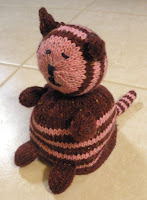I love my cats dearly and wouldn’t change or trade them for anything, but I always thought Portia would be the cat that would drive me to drink. She has it out for all yarn, and has learned to open my closets in order to get to any possible secret stashes. Every time I work on a project, I am guaranteed to have a guardian with a helping paw or four. When I'm sewing, I always have to remove the warm, cat-shaped fabric weight before I can actually use my machine. And her history with Christmas ornaments is well known.
 Human, you are mistaken. This is my nest, not your fabric.
Human, you are mistaken. This is my nest, not your fabric.
This year, I should have known better when not a single ornament was drowned, taken off the tree, or disturbed in any way. She was buttering me up – for Nicholas.
A few nights after Christmas, I was curled up with a knitting project, doing the final assembly of some knitted boxes that were getting fabric lining. It was a rare bit of hand sewing, and I was remembering how much I liked doing that. In a silly bit of vacation-time overachieving, I was also trying to speed-defrost my freezer (at 10pm at night). Getting up to refresh the containers of hot water in the freezer from the just-having-whistled teakettle, I put the sewing needle and leftover bit of thread aside on my magnetic pin rest. A pin rest which is usually neatly contained in my new sewing cabinet.
While I was in the kitchen, that lovely, unique yowl rang out that most cat owners know as the warning signal of that most delightful gift, the hairball. I looked over to track Nicholas so I would know where the necessary cleanup would be needed. The details I'll spare, but the delivery wasn't his normal behavior at all, and when he started growling at Portia I got alarmed. After watching him some more I knew that he was in distress, and I prepared for a whopper of a cleanup – but the gift never arrived and he wandered off. So I curled back up to finish sewing and went to pick up my needle, but it was gone. The little bit of thread that had been hanging from the needle was also nowhere to be found.
After searching all around and in my chair, still no needle or thread. I tried to check Nico’s mouth, but he wanted absolutely nothing to do with that, thank you very much! I called my parents, slightly panicked. Had they ever had a cat eat something like this? I called the vet and left a message, asking if they could give me any advice. To say that I slept well that night or that the next day was easy would be a lie. All the vet could say to do was watch Nico’s behavior – but he was eating, playing, and using the litter box as normal.
I’m kicking myself now, but it was a day and a half until the uncertainty got to me, and we went in for an x-ray (of course, the day before New Year’s Eve). The minute the vet came back, I knew, and to say that my heart sank was putting it mildly. The needle had somehow made it – and I’ll never know how it did so safely – all the way to Nico’s colon, and was now lined up almost perfectly with his backbone and resting about two inches from his tail. Surgery was an option, but it’d be tough to do it cleanly or easily. There was a slim option that it might pass, or that the vet would get lucky and be able to retrieve it from, well, behind. Nico got checked in and the vet went to work almost immediately. Some people might not think it’s worth praying for an animal, but boy was I working on that for the next couple of hours.
Somehow, by some stroke of amazing luck and a lot of careful work by the vet (and probably some details I don’t want to know and Nico thankfully won’t ever remember), surgery was avoided. I got to go pick up a slightly dopey but oh so happy cat. The vet got to keep the needle and thread.
 A duplicate to the ingested needle, measuring in at 1 11/16”
A duplicate to the ingested needle, measuring in at 1 11/16”
Moral of the story? Once cats start eating thread, they are literally hooked and reel it in until they find the end. Nico’s saving grace was that the needle at the end of his thread went down non-pointy end first, and his cast-iron stomach saved the day.

Picture is from May, I didn’t want to show his poor, shaved backside.
But that look of relief is very accurate!
For the first few days back home, pain meds were a necessity for the poor guy, as he was moving around like an old man and could barely jump onto the bed. Now we’ve mostly returned to normal, since Portia finally realized that Nico is not some alien creature, trying to take over her space and human (he must have reeked of the vet that first day back, and she would not stop growling or hissing at him, or swatting when he got too close). Needless to say, all crafting supplies are even more securely stashed away, and no feline is left unattended around any yarn or thread. We’ve all learned our lesson!!
 Before (notice the nicks along the top and inner corners)
Before (notice the nicks along the top and inner corners)











































